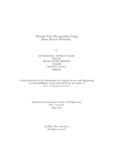| dc.contributor.advisor | Huq, Aminul | |
| dc.contributor.advisor | Reza, Tanzim | |
| dc.contributor.author | Akash, MD Shahadat Hossain | |
| dc.contributor.author | Sharife, Shadman Bin | |
| dc.contributor.author | Datta, Bondon | |
| dc.date.accessioned | 2023-12-07T06:27:15Z | |
| dc.date.available | 2023-12-07T06:27:15Z | |
| dc.date.copyright | 2023 | |
| dc.date.issued | 2023-06 | |
| dc.identifier.other | ID 19101440 | |
| dc.identifier.other | ID 22241139 | |
| dc.identifier.other | ID 19101143 | |
| dc.identifier.uri | http://hdl.handle.net/10361/21936 | |
| dc.description | This thesis is submitted in partial fulfillment of the requirements for the degree of Bachelor of Science in Computer Science, 2023. | en_US |
| dc.description | Cataloged from PDF version of thesis. | |
| dc.description | Includes bibliographical references (pages 39-40). | |
| dc.description.abstract | One of the most effective biometric tools for securing diverse systems is facial recog-
nition technology. Traditional security mechanisms like PINs, passwords, and fin-
gerprints have shown to be less effective and dependable than this technology. Sys-
tems for surveillance, finance, and security have all made substantial use of facial
recognition technology. But facial recognition technology is currently facing a huge
challenge from the COVID-19 pandemic. Due to face occlusion brought on by the
widespread use of masks, it is now challenging to precisely identify people. This
problem has motivated a number of academics to develop facial recognition tech-
nology that is more accurate by focusing on hidden facial features. In this paper,
we provide a sophisticated method for identifying faces even when there are facial
alterations or masks are used. The CASIA, VGG2, LFW Databases are used to
help us build our technique, which entails figuring out which facial traits are still
discernible even when the face is partially hidden. Convolutional neural networks
(CNNs), which are the foundation of our method and are used to extract perti-
nent facial information, are based on deep learning techniques. We contrasted our
findings with those of other cutting-edge facial recognition systems to assess our
strategy. By obtaining more accuracy and speed, our system outperformed other
systems. We got 95.85% accuracy in face recognition with the model Inception-
ResNetV1 by using ArcFace loss function. Also got 94.28% accuracy on the same
model by using Triplet loss function. We worked on the never before worked model
for face recognition which is SE-ResNeXt-101. We also got 93.41% accuracy on that
model with ArcFace loss function. That indicates that our research underlines the
significance of creating environmental change-resistant facial recognition | en_US |
| dc.description.statementofresponsibility | MD Shahadat Hossain Akash | |
| dc.description.statementofresponsibility | Shadman Bin Sharife | |
| dc.description.statementofresponsibility | Bondon Datta | |
| dc.format.extent | 40 pages | |
| dc.language.iso | en | en_US |
| dc.publisher | Brac University | en_US |
| dc.rights | Brac University theses are protected by copyright. They may be viewed from this source for any purpose, but reproduction or distribution in any format is prohibited without written permission. | |
| dc.subject | Facial recognition | en_US |
| dc.subject | Face detection | en_US |
| dc.subject | Convolution Neural Networks | en_US |
| dc.subject | Deep Neural Network | en_US |
| dc.subject | InceptionResNetV1 | en_US |
| dc.subject | ArcFace loss function | en_US |
| dc.subject | SE-ResNeXt-101 | en_US |
| dc.subject | Triplet loss function | en_US |
| dc.subject.lcsh | Facial expression. | |
| dc.subject.lcsh | Artificial intelligence | |
| dc.subject.lcsh | Neural networks (Computer science) | |
| dc.title | Obscure face recognition using deep neural networks | en_US |
| dc.type | Thesis | en_US |
| dc.contributor.department | Department of Computer Science and Engineering, Brac University | |
| dc.description.degree | B.Sc. in Computer Science and Engineering | |

